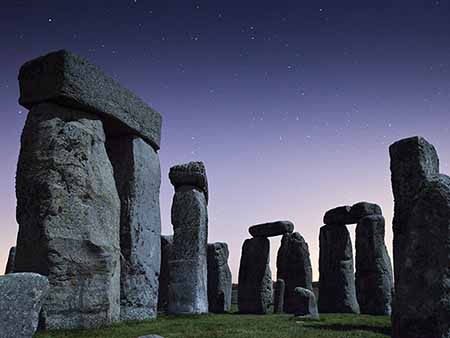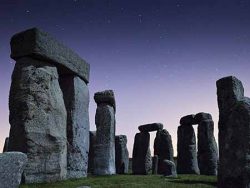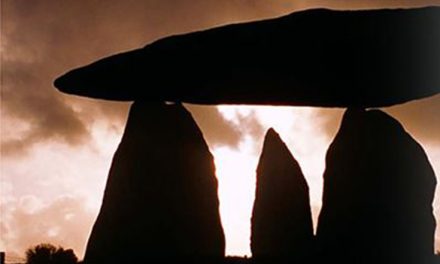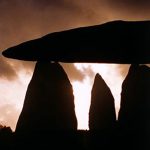Stonehenge. One of the world’s most recognizable enigmas. Rising up from the wide, grassy Salisbury plain, these precisely placed giant monoliths defy common logic and inspire endless questions (and sometimes priceless song lyrics) in anyone who sees them.
I distinctly remember the first time I saw pictures of the amazing stones. I was a kid in sixth grade watching a documentary in class done by some scientific dude who had done calculations to prove that the ancient site was a calendar. When the image of the sun rising over the Heel Stone on the summer solstice flashed across the screen, something seemed to sear into my wee brain and it triggered a drive to get myself to that place somehow to see and feel those stones for myself.
My first visit to the site came when I was in my early twenties traveling through Britain for several weeks. I was thrilled to finally see the famous monument that had impressed me so deeply a decade earlier, but I was completely sideswiped and disappointed to find the stones had been roped off for visitors and were far beyond my reach. I called a silent “hello!” to the giant gray blocks and made up my mind that I would have to come back again somehow for a more satisfying connection with the site.
In 1993 I returned to England with a tiny group of twelve intent on experiencing some of the powerful energetics hidden within the British landscape. We hit Stonehenge on the night of one of the Neptune-Uranus conjunctions and for me, it was the culmination of my long-standing desire to take myself into the heart of the ancient site.
We arrived before sundown just as the last of the tourists were being ushered out for the evening. My group had paid for the privilege of a private visit after public hours (yes, the English Heritage Trust allows this for a bit of moolah), so we had the site all to ourselves for the entire evening. I was stoked. We were told not to touch anything (!?!) before we took off across the grass, trailed by a couple of wandering security guards.

After happily jumping the ropes, I walked a short way with my group who then moved on and scattered like wraiths among the stones. I wanted to ease my way into the site, so I took off at a brisk walk around the rim of the henge, making a complete circuit before moving steadily inward, ending with a lap just outside the looming stones. When I found myself at the midpoint of the four linteled sarsens, it seemed to be a good place to enter, so I walked between the two monoliths, feathering my fingertips across the sides of the stones as I passed (shame on me!), and entered the grounds that had once been the inner sanctum contained within the joined ring.
As I continued my spiral toward the center, stepping carefully around the fallen bluestones, I was struck by how small the space inside felt, especially within the inner horseshoe of trilithons. The towering stones were massive, yes, but the inner rings felt oddly crowded. I was surprised by the sensation. When at last I reached the middle of the site, I stepped into the grassy area between several fallen stones, walked to the spot I gauged to be the very center, and then lifted my arms and began to spin. I made quite a few rotations before I brought my feet down firmly and looked up. The stars were just coming out in a crystal clear night sky.
As a side note, a friend of mine back in Colorado told me after I returned home that she had been meditating during the time she thought we were to be in Stonehenge and suddenly felt caught in a whirlwind before finding herself there. Hmmmm……
After wandering around a bit, my group collected at the foot of one of the inner trilithons and sat down to talk for a while. One of my friends noted that I was “all lit up,” an apt description for how I felt. As I sat and looked up at the silent stones shadowed against the blanket of stars overhead, the distinct sensation of familiarity came through as well as an intelligent presence within them. It felt like I was visiting old friends. I also had the impression that the space within the ring was connected or could connect with something or someone else — another place or time? Another mind?
When we finally walked away from the site across the grass, I felt a deep satisfaction that I had accomplished something I’d wanted to do for a long time. I was still charged and wouldn’t sleep much the rest of the night, but I carried away my own private connection to the site which I can tap into anytime I close my eyes. A personal milestone to say the least.
I’ve thought a lot about that collection of rocks since my visit. Do I have any thing profound to add to the wide assortment of speculation as to how and why the construct was built? Don’t know, but I can say this with utmost certainty: science isn’t big enough yet to understand the “ancient” sites on this globe. I don’t believe Stonehenge or most of the other megalithic structures raised during the same era were built for the benefit of humans at all or necessarily even built by humans.
 To purport that the local human culture of the time could cut and roll such large stones for miles using nothing but wooden logs and then erect them in exact positions to mark astronomical events is patently absurd. There’s a technology or bit of physics missing from that explanation, not to mention some basic imagination.
To purport that the local human culture of the time could cut and roll such large stones for miles using nothing but wooden logs and then erect them in exact positions to mark astronomical events is patently absurd. There’s a technology or bit of physics missing from that explanation, not to mention some basic imagination.
Was the site built by giants as 12th century Geoffrey of Monmouth suggested in his Historia Regum Britanniae? That’s not as outlandish as many skeptics may think. An abundance of evidence and lore in Britain alone indicate a presence of large humanoids in centuries past (see Anthony Roberts’ book, Sowers of Thunder).
But regardless of who actually built Stonehenge or how they managed to pull it off, the much more compelling questions are these: Who designed it and why?
Scientists have measured the stones and made enough calculations to prove some pretty impressive mathematics were put to use in the site’s plan and construction which can also be said about many other stone sites on the planet. The level of knowledge and intelligence found within these structures doesn’t sync up with the accepted views of primitive people. Either the assumptions about the human cultures of the era are completely wrong or else the designers of the sites belonged to an entirely different group, perhaps using local humans for labor during construction.
That said, to assume that the masterminds behind the site were human is myopic and to dismiss them as no longer alive or present is short-sighted. The identity and purpose of the architects of countless megalithic sites around the globe are part of ongoing debates among many researchers and thinkers which I will explore in other articles.
For the moment, I will leave you with this thought. Exactly what kind of being would need intricate constructs built in stone across the surface of the earth geared to read planetary and specific stellar energetics with a high degree of precision?
Perhaps someone who wished to harness, control, and harvest the enormous streams of energy produced by this amazing planet. For what purpose? And what were/are the ramifications for human beings on the surface? The answers to those questions remain to be seen.

Erin MacMichael is a visionary science fiction author and artist, creator of the T'nari Renegades series of novellas, novels, covers, and artwork. Her lifelong quest has been to explore past the boundaries of conventional thinking and figure out what really has transpired on this planet. She has traveled extensively throughout the world and lives in the Pacific Northwest with her marvelous offspring.
Stonehenge. One of the world’s most recognizable enigmas. Rising up from the wide, grassy Salisbury plain, these precisely placed giant monoliths defy common logic and inspire endless questions (and sometimes priceless song lyrics) in anyone who sees them.
I distinctly remember the first time I saw pictures of the amazing stones. I was a kid in sixth grade watching a documentary in class done by some scientific dude who had done calculations to prove that the ancient site was a calendar. When the image of the sun rising over the Heel Stone on the summer solstice flashed across the screen, something seemed to sear into my wee brain and it triggered a drive to get myself to that place somehow to see and feel those stones for myself.
My first visit to the site came when I was in my early twenties traveling through Britain for several weeks. I was thrilled to finally see the famous monument that had impressed me so deeply a decade earlier, but I was completely sideswiped and disappointed to find the stones had been roped off for visitors and were far beyond my reach. I called a silent “hello!” to the giant gray blocks and made up my mind that I would have to come back again somehow for a more satisfying connection with the site.
In 1993 I returned to England with a tiny group of twelve intent on experiencing some of the powerful energetics hidden within the British landscape. We hit Stonehenge on the night of one of the Neptune-Uranus conjunctions and for me, it was the culmination of my long-standing desire to take myself into the heart of the ancient site.
We arrived before sundown just as the last of the tourists were being ushered out for the evening. My group had paid for the privilege of a private visit after public hours (yes, the English Heritage Trust allows this for a bit of moolah), so we had the site all to ourselves for the entire evening. I was stoked. We were told not to touch anything (!?!) before we took off across the grass, trailed by a couple of wandering security guards.

After happily jumping the ropes, I walked a short way with my group who then moved on and scattered like wraiths among the stones. I wanted to ease my way into the site, so I took off at a brisk walk around the rim of the henge, making a complete circuit before moving steadily inward, ending with a lap just outside the looming stones. When I found myself at the midpoint of the four linteled sarsens, it seemed to be a good place to enter, so I walked between the two monoliths, feathering my fingertips across the sides of the stones as I passed (shame on me!), and entered the grounds that had once been the inner sanctum contained within the joined ring.
As I continued my spiral toward the center, stepping carefully around the fallen bluestones, I was struck by how small the space inside felt, especially within the inner horseshoe of trilithons. The towering stones were massive, yes, but the inner rings felt oddly crowded. I was surprised by the sensation. When at last I reached the middle of the site, I stepped into the grassy area between several fallen stones, walked to the spot I gauged to be the very center, and then lifted my arms and began to spin. I made quite a few rotations before I brought my feet down firmly and looked up. The stars were just coming out in a crystal clear night sky.
As a side note, a friend of mine back in Colorado told me after I returned home that she had been meditating during the time she thought we were to be in Stonehenge and suddenly felt caught in a whirlwind before finding herself there. Hmmmm……
After wandering around a bit, my group collected at the foot of one of the inner trilithons and sat down to talk for a while. One of my friends noted that I was “all lit up,” an apt description for how I felt. As I sat and looked up at the silent stones shadowed against the blanket of stars overhead, the distinct sensation of familiarity came through as well as an intelligent presence within them. It felt like I was visiting old friends. I also had the impression that the space within the ring was connected or could connect with something or someone else — another place or time? Another mind?
When we finally walked away from the site across the grass, I felt a deep satisfaction that I had accomplished something I’d wanted to do for a long time. I was still charged and wouldn’t sleep much the rest of the night, but I carried away my own private connection to the site which I can tap into anytime I close my eyes. A personal milestone to say the least.
I’ve thought a lot about that collection of rocks since my visit. Do I have any thing profound to add to the wide assortment of speculation as to how and why the construct was built? Don’t know, but I can say this with utmost certainty: science isn’t big enough yet to understand the “ancient” sites on this globe. I don’t believe Stonehenge or most of the other megalithic structures raised during the same era were built for the benefit of humans at all or necessarily even built by humans.
To purport that the local human culture of the time could cut and roll such large stones for miles using nothing but wooden logs and then erect them in exact positions to mark astronomical events is patently absurd. There’s a technology or bit of physics missing from that explanation, not to mention some basic imagination.

Was the site built by giants as 12th century Geoffrey of Monmouth suggested in his Historia Regum Britanniae? That’s not as outlandish as many skeptics may think. An abundance of evidence and lore in Britain alone indicate a presence of large humanoids in centuries past (see Anthony Roberts’ book, Sowers of Thunder).
But regardless of who actually built Stonehenge or how they managed to pull it off, the much more compelling questions are these: Who designed it and why?
Scientists have measured the stones and made enough calculations to prove some pretty impressive mathematics were put to use in the site’s plan and construction which can also be said about many other stone sites on the planet. The level of knowledge and intelligence found within these structures doesn’t sync up with the accepted views of primitive people. Either the assumptions about the human cultures of the era are completely wrong or else the designers of the sites belonged to an entirely different group, perhaps using local humans for labor during construction.
That said, to assume that the masterminds behind the site were human is myopic and to dismiss them as no longer alive or present is short-sighted. The identity and purpose of the architects of countless megalithic sites around the globe are part of ongoing debates among many researchers and thinkers which I will explore in other articles.
For the moment, I will leave you with this thought. Exactly what kind of being would need intricate constructs built in stone across the surface of the earth geared to read planetary and specific stellar energetics with a high degree of precision?
Perhaps someone who wished to harness, control, and harvest the enormous streams of energy produced by this amazing planet. For what purpose? And what were/are the ramifications for human beings on the surface? The answers to those questions remain to be seen.

Erin MacMichael is a visionary science fiction author and artist, creator of the T'nari Renegades series of novellas, novels, covers, and artwork. Her lifelong quest has been to explore past the boundaries of conventional thinking and figure out what really has transpired on this planet. She has traveled extensively throughout the world and lives in the Pacific Northwest with her marvelous offspring.

Erin MacMichael is a visionary science fiction author and artist, creator of the T'nari Renegades series of novellas, novels, covers, and artwork. Her lifelong quest has been to explore past the boundaries of conventional thinking and figure out what really has transpired on this planet. She has traveled extensively throughout the world and lives in the Pacific Northwest with her marvelous offspring.
0 Comments
Stonehenge. One of the world’s most recognizable enigmas. Rising up from the wide, grassy Salisbury plain, these precisely placed giant monoliths defy common logic and inspire endless questions (and sometimes priceless song lyrics) in anyone who sees them.
I distinctly remember the first time I saw pictures of the amazing stones. I was a kid in sixth grade watching a documentary in class done by some scientific dude who had done calculations to prove that the ancient site was a calendar. When the image of the sun rising over the Heel Stone on the summer solstice flashed across the screen, something seemed to sear into my wee brain and it triggered a drive to get myself to that place somehow to see and feel those stones for myself.
My first visit to the site came when I was in my early twenties traveling through Britain for several weeks. I was thrilled to finally see the famous monument that had impressed me so deeply a decade earlier, but I was completely sideswiped and disappointed to find the stones had been roped off for visitors and were far beyond my reach. I called a silent “hello!” to the giant gray blocks and made up my mind that I would have to come back again somehow for a more satisfying connection with the site.
In 1993 I returned to England with a tiny group of twelve intent on experiencing some of the powerful energetics hidden within the British landscape. We hit Stonehenge on the night of one of the Neptune-Uranus conjunctions and for me, it was the culmination of my long-standing desire to take myself into the heart of the ancient site.
We arrived before sundown just as the last of the tourists were being ushered out for the evening. My group had paid for the privilege of a private visit after public hours (yes, the English Heritage Trust allows this for a bit of moolah), so we had the site all to ourselves for the entire evening. I was stoked. We were told not to touch anything (!?!) before we took off across the grass, trailed by a couple of wandering security guards.

After happily jumping the ropes, I walked a short way with my group who then moved on and scattered like wraiths among the stones. I wanted to ease my way into the site, so I took off at a brisk walk around the rim of the henge, making a complete circuit before moving steadily inward, ending with a lap just outside the looming stones. When I found myself at the midpoint of the four linteled sarsens, it seemed to be a good place to enter, so I walked between the two monoliths, feathering my fingertips across the sides of the stones as I passed (shame on me!), and entered the grounds that had once been the inner sanctum contained within the joined ring.
As I continued my spiral toward the center, stepping carefully around the fallen bluestones, I was struck by how small the space inside felt, especially within the inner horseshoe of trilithons. The towering stones were massive, yes, but the inner rings felt oddly crowded. I was surprised by the sensation. When at last I reached the middle of the site, I stepped into the grassy area between several fallen stones, walked to the spot I gauged to be the very center, and then lifted my arms and began to spin. I made quite a few rotations before I brought my feet down firmly and looked up. The stars were just coming out in a crystal clear night sky.
As a side note, a friend of mine back in Colorado told me after I returned home that she had been meditating during the time she thought we were to be in Stonehenge and suddenly felt caught in a whirlwind before finding herself there. Hmmmm……
After wandering around a bit, my group collected at the foot of one of the inner trilithons and sat down to talk for a while. One of my friends noted that I was “all lit up,” an apt description for how I felt. As I sat and looked up at the silent stones shadowed against the blanket of stars overhead, the distinct sensation of familiarity came through as well as an intelligent presence within them. It felt like I was visiting old friends. I also had the impression that the space within the ring was connected or could connect with something or someone else — another place or time? Another mind?
When we finally walked away from the site across the grass, I felt a deep satisfaction that I had accomplished something I’d wanted to do for a long time. I was still charged and wouldn’t sleep much the rest of the night, but I carried away my own private connection to the site which I can tap into anytime I close my eyes. A personal milestone to say the least.
I’ve thought a lot about that collection of rocks since my visit. Do I have any thing profound to add to the wide assortment of speculation as to how and why the construct was built? Don’t know, but I can say this with utmost certainty: science isn’t big enough yet to understand the “ancient” sites on this globe. I don’t believe Stonehenge or most of the other megalithic structures raised during the same era were built for the benefit of humans at all or necessarily even built by humans.
To purport that the local human culture of the time could cut and roll such large stones for miles using nothing but wooden logs and then erect them in exact positions to mark astronomical events is patently absurd. There’s a technology or bit of physics missing from that explanation, not to mention some basic imagination.

Was the site built by giants as 12th century Geoffrey of Monmouth suggested in his Historia Regum Britanniae? That’s not as outlandish as many skeptics may think. An abundance of evidence and lore in Britain alone indicate a presence of large humanoids in centuries past (see Anthony Roberts’ book, Sowers of Thunder).
But regardless of who actually built Stonehenge or how they managed to pull it off, the much more compelling questions are these: Who designed it and why?
Scientists have measured the stones and made enough calculations to prove some pretty impressive mathematics were put to use in the site’s plan and construction which can also be said about many other stone sites on the planet. The level of knowledge and intelligence found within these structures doesn’t sync up with the accepted views of primitive people. Either the assumptions about the human cultures of the era are completely wrong or else the designers of the sites belonged to an entirely different group, perhaps using local humans for labor during construction.
That said, to assume that the masterminds behind the site were human is myopic and to dismiss them as no longer alive or present is short-sighted. The identity and purpose of the architects of countless megalithic sites around the globe are part of ongoing debates among many researchers and thinkers which I will explore in other articles.
For the moment, I will leave you with this thought. Exactly what kind of being would need intricate constructs built in stone across the surface of the earth geared to read planetary and specific stellar energetics with a high degree of precision?
Perhaps someone who wished to harness, control, and harvest the enormous streams of energy produced by this amazing planet. For what purpose? And what were/are the ramifications for human beings on the surface? The answers to those questions remain to be seen.

Erin MacMichael is a visionary science fiction author and artist, creator of the T'nari Renegades series of novellas, novels, covers, and artwork. Her lifelong quest has been to explore past the boundaries of conventional thinking and figure out what really has transpired on this planet. She has traveled extensively throughout the world and lives in the Pacific Northwest with her marvelous offspring.

Erin MacMichael is a visionary science fiction author and artist, creator of the T'nari Renegades series of novellas, novels, covers, and artwork. Her lifelong quest has been to explore past the boundaries of conventional thinking and figure out what really has transpired on this planet. She has traveled extensively throughout the world and lives in the Pacific Northwest with her marvelous offspring.













0 Comments